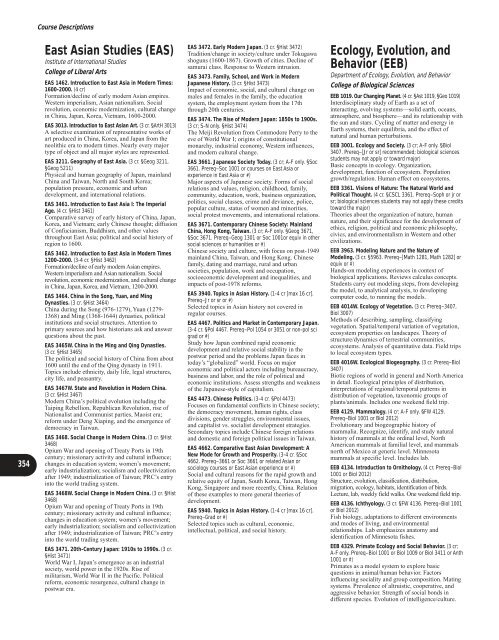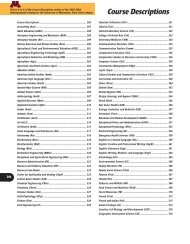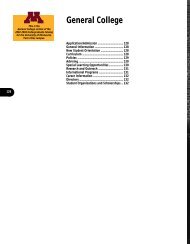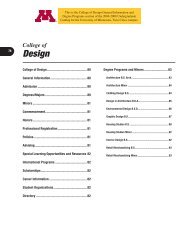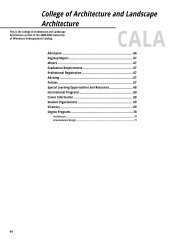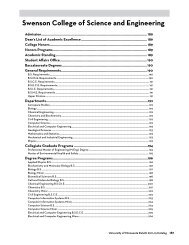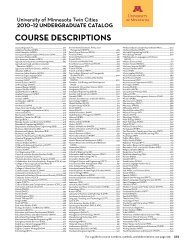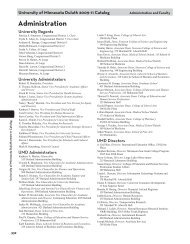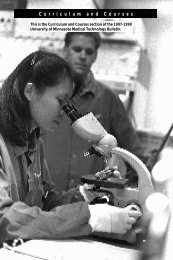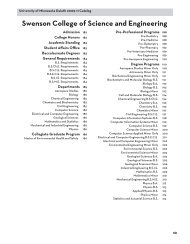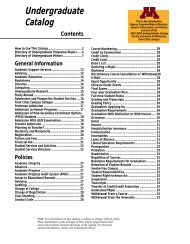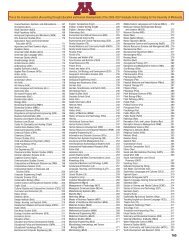Course Descriptions354East Asian Studies (EAS)Institute <strong>of</strong> International StudiesCollege <strong>of</strong> Liberal ArtsEAS 1462. Introduction to East Asia in Modern Times:1600-2000. (4 cr)Formation/decline <strong>of</strong> early modern Asian empires.Western imperialism, Asian nationalism. Socialrevolution, economic modernization, cultural changein China, Japan, Korea, Vietnam, 1600-2000.EAS 3013. Introduction to East Asian Art. (3 cr. §ArtH 3013)A selective examination <strong>of</strong> representative works <strong>of</strong>art produced in China, Korea, and Japan from theneolithic era to modern times. Nearly every majortype <strong>of</strong> object and all major styles are represented.EAS 3211. Geography <strong>of</strong> East Asia. (3 cr. §Geog 3211,§Geog 5211)Physical and human geography <strong>of</strong> Japan, mainlandChina and Taiwan, North and South Korea;population pressure, economic and urbandevelopment, and international relations.EAS 3461. Introduction to East Asia I: The ImperialAge. (4 cr. §Hist 3461)Comparative survey <strong>of</strong> early history <strong>of</strong> China, Japan,Korea, and Vietnam; early Chinese thought; diffusion<strong>of</strong> Confucianism, Buddhism, and other values<strong>through</strong>out East Asia; political and social history <strong>of</strong>region to 1600.EAS 3462. Introduction to East Asia in Modern Times1200-2000. (3-4 cr. §Hist 3462)Formation/decline <strong>of</strong> early modern Asian empires.Western imperialism and Asian nationalism. Socialrevolution, economic modernization, and cultural changein China, Japan, Korea, and Vietnam, 1200-2000.EAS 3464. China in the Song, Yuan, and MingDynasties. (3 cr. §Hist 3464)China during the Song (976-1279), Yuan (1279-1368) and Ming (1368-1644) dynasties, politicalinstitutions and social structures. Attention toprimary sources and how historians ask and answerquestions about the past.EAS 3465W. China in the Ming and Qing Dynasties.(3 cr. §Hist 3465)The political and social history <strong>of</strong> China from about1600 until the end <strong>of</strong> the Qing dynasty in 1911.Topics include ethnicity, daily life, legal structures,city life, and peasantry.EAS 3467W. State and Revolution in Modern China.(3 cr. §Hist 3467)Modern China’s political evolution including theTaiping Rebellion, Republican Revolution, rise <strong>of</strong>Nationalist and Communist parties, Maoist era;reform under Deng Xiaping, and the emergence <strong>of</strong>democracy in Taiwan.EAS 3468. Social Change in Modern China. (3 cr. §Hist3468)Opium War and opening <strong>of</strong> Treaty Ports in 19thcentury; missionary activity and cultural influence;changes in education system; women’s movement;early industrialization; socialism and collectivizationafter 1949; industrialization <strong>of</strong> Taiwan; PRC’s entryinto the world trading system.EAS 3468W. Social Change in Modern China. (3 cr. §Hist3468)Opium War and opening <strong>of</strong> Treaty Ports in 19thcentury; missionary activity and cultural influence;changes in education system; women’s movement;early industrialization; socialism and collectivizationafter 1949; industrialization <strong>of</strong> Taiwan; PRC’s entryinto the world trading system.EAS 3471. 20th-Century Japan: 1910s to 1990s. (3 cr.§Hist 3471)World War I, Japan’s emergence as an industrialsociety, world power in the 1920s. Rise <strong>of</strong>militarism, World War II in the Pacific. Politicalreform, economic resurgence, cultural change inpostwar era.EAS 3472. Early Modern Japan. (3 cr. §Hist 3472)Tradition/change in society/culture under Tokugawashoguns (1600-1867). Growth <strong>of</strong> cities. Decline <strong>of</strong>samurai class. Response to Western intrusion.EAS 3473. Family, School, and Work in ModernJapanese History. (3 cr. §Hist 3473)Impact <strong>of</strong> economic, social, and cultural change onmales and females in the family, the educationsystem, the employment system from the 17th<strong>through</strong> 20th centuries.EAS 3474. The Rise <strong>of</strong> Modern Japan: 1850s to 1900s.(3 cr; S-N only. §Hist 3474)The Meiji Revolution from Commodore Perry to theeve <strong>of</strong> World War I; origins <strong>of</strong> constitutionalmonarchy, industrial economy, Western influences,and modern cultural change.EAS 3661. Japanese Society Today. (3 cr; A-F only. §Soc3661. Prereq–Soc 1001 or courses on East Asia orexperience in East Asia or #)Major aspects <strong>of</strong> Japanese society. Forms <strong>of</strong> socialrelations and values, religion, childhood, family,community, education, work, business organization,politics, social classes, crime and deviance, police,popular culture, status <strong>of</strong> women and minorities,social protest movements, and international relations.EAS 3671. Contemporary Chinese Society: MainlandChina, Hong Kong, Taiwan. (3 cr; A-F only. §Geog 3671,§Soc 3671. Prereq–Geog 1301 or Soc 1001or equiv in othersocial sciences or humanities or #)Chinese society and culture, with focus on post-1949mainland China, Taiwan, and Hong Kong. Chinesefamily, dating and marriage, rural and urbansocieties, population, work and occupation,socioeconomic development and inequalities, andimpacts <strong>of</strong> post-1978 reforms.EAS 3940. Topics in Asian History. (1-4 cr [max 16 cr].Prereq–Jr or sr or #)Selected topics in Asian history not covered inregular courses.EAS 4467. Politics and Market in Contemporary Japan.(3-4 cr. §Pol 4467. Prereq–Pol 1054 or 3051 or non-pol scigrad or #)Study how Japan combined rapid economicdevelopment and relative social stability in thepostwar period and the problems Japan faces intoday’s “globalized” world. Focus on majoreconomic and political actors including bureaucracy,business and labor, and the role <strong>of</strong> political andeconomic institutions. Assess strengths and weakness<strong>of</strong> the Japanese-style <strong>of</strong> capitalism.EAS 4473. Chinese Politics. (3-4 cr. §Pol 4473)Focuses on fundamental conflicts in Chinese society;the democracy movement, human rights, classdivisions, gender struggles, environmental issues,and capitalist vs. socialist development strategies.Secondary topics include Chinese foreign relationsand domestic and foreign political issues in Taiwan.EAS 4662. Comparative East Asian Development: ANew Mode for Growth and Prosperity. (3-4 cr. §Soc4662. Prereq–3661 or Soc 3661 or related Asian orsociology courses or East Asian experience or #)Social and cultural reasons for the rapid growth andrelative equity <strong>of</strong> Japan, South Korea, Taiwan, HongKong, Singapore and more recently, China. Relation<strong>of</strong> these examples to more general theories <strong>of</strong>development.EAS 5940. Topics in Asian History. (1-4 cr [max 16 cr].Prereq–Grad or #)Selected topics such as cultural, economic,intellectual, political, and social history.Ecology, Evolution, andBehavior (EEB)Department <strong>of</strong> Ecology, Evolution, and BehaviorCollege <strong>of</strong> Biological SciencesEEB 1019. Our Changing Planet. (4 cr. §Ast 1019, §Geo 1019)Interdisciplinary study <strong>of</strong> Earth as a set <strong>of</strong>interacting, evolving systems—solid earth, oceans,atmosphere, and biosphere—and its relationship withthe sun and stars. Cycling <strong>of</strong> matter and energy inEarth systems, their equilibria, and the effect <strong>of</strong>natural and human perturbations.EEB 3001. Ecology and Society. (3 cr; A-F only. §Biol3407. Prereq–[Jr or sr] recommended; biological sciencesstudents may not apply cr toward major)Basic concepts in ecology. Organization,development, function <strong>of</strong> ecosystem. Populationgrowth/regulation. Human effect on ecosystems.EEB 3361. Visions <strong>of</strong> Nature: The Natural World andPolitical Thought. (4 cr. §CSCL 3361. Prereq–Soph or jr orsr; biological sciences students may not apply these creditstoward the major)Theories about the organization <strong>of</strong> nature, humannature, and their significance for the development <strong>of</strong>ethics, religion, political and economic philosophy,civics, and environmentalism in Western and othercivilizations.EEB 3963. Modeling Nature and the Nature <strong>of</strong>Modeling. (3 cr. §5963. Prereq–[Math 1281, Math 1282] orequiv or #)Hands-on modeling experiences in context <strong>of</strong>biological applications. Reviews calculus concepts.Students carry out modeling steps, from developingthe model, to analytical analysis, to developingcomputer code, to running the models.EEB 4014W. Ecology <strong>of</strong> Vegetation. (3 cr. Prereq–3407,Biol 3007)Methods <strong>of</strong> describing, sampling, classifyingvegetation. Spatial/temporal variation <strong>of</strong> vegetation,ecosystem properties on landscapes. Theory <strong>of</strong>structure/dynamics <strong>of</strong> terrestrial communities,ecosystems. Analysis <strong>of</strong> quantitative data. Field tripsto local ecosystem types.EEB 4016W. Ecological Biogeography. (3 cr. Prereq–Biol3407)Biotic regions <strong>of</strong> world in general and North Americain detail. Ecological principles <strong>of</strong> distribution,interpretations <strong>of</strong> regional/temporal patterns indistribution <strong>of</strong> vegetation, taxonomic groups <strong>of</strong>plants/animals. Includes one weekend field trip.EEB 4129. Mammalogy. (4 cr; A-F only. §FW 4129.Prereq–Biol 1001 or Biol 2012)Evolutionary and biogeographic history <strong>of</strong>mammalia. Recognize, identify, and study naturalhistory <strong>of</strong> mammals at the ordinal level, NorthAmerican mammals at familial level, and mammalsnorth <strong>of</strong> Mexico at generic level. Minnesotamammals at specific level. Includes lab.EEB 4134. Introduction to Ornithology. (4 cr. Prereq–Biol1001 or Biol 2012)Structure, evolution, classification, distribution,migration, ecology, habitats, identification <strong>of</strong> birds.Lecture, lab, weekly field walks. One weekend field trip.EEB 4136. Ichthyology. (3 cr. §FW 4136. Prereq–Biol 1001or Biol 2012)Fish biology, adaptations to different environmentsand modes <strong>of</strong> living, and environmentalrelationships. Lab emphasizes anatomy andidentification <strong>of</strong> Minnesota fishes.EEB 4329. Primate Ecology and Social Behavior. (3 cr;A-F only. Prereq–Biol 1001 or Biol 1009 or Biol 3411 or Anth1001 or #)Primates as a model system to explore basicquestions in animal/human behavior. Factorsinfluencing sociality and group composition. Matingsystems. Prevalence <strong>of</strong> altruistic, cooperative, andaggressive behavior. Strength <strong>of</strong> social bonds indifferent species. Evolution <strong>of</strong> intelligence/culture.
Course DescriptionsEEB 4601. Limnology. (3 cr; A-F only. §Geo 4601. Prereq–Chem 1022)Description and analysis <strong>of</strong> lakes and other aquaticenvironments beginning with lake origins andprogressing <strong>through</strong> lake physics, chemistry, andbiology. Interrelationships among these topics andeffects <strong>of</strong> human activities.EEB 4605. Limnology Laboratory. (1 cr; A-F only. §Geo4605. Prereq–4601 or #)Field and lab methods used to obtain information onenvironmental conditions in aquatic environmentsand measure the abundance <strong>of</strong> aquatic organisms,especially plankton. Field/lab instruments, samplingdevices, microscopy, water chemistry, data analysis.EEB 4607. Plankton Ecology. (4 cr; A-F only. Prereq–4601or Geo 4601)Planktonic bacteria, algae, and animals in lakes,reservoirs, and oceans with special attention toprocesses that cause variations <strong>of</strong> abundance.EEB 4609W. Ecosystem Ecology. (3 cr. Prereq–Biol 3407)Regulation <strong>of</strong> energy and elements cycling <strong>through</strong>ecosystems; dependence <strong>of</strong> the cycles on kinds andnumbers <strong>of</strong> species within ecosystems; effects <strong>of</strong>human-induced global changes on the functioning <strong>of</strong>ecosystems.EEB 4611. Biogeochemical Processes. (3 cr. Prereq–[Chem 2301, [Biol 2032 or MicB 2032 or VPB 2032 or Biol or3301 or MicB 3301], Phys 1201] or #)Application <strong>of</strong> biochemistry, ecology, chemistry, andphysics to environmental issues. Current issues inbiogeochemistry. Impact <strong>of</strong> humans on biogeochemicalprocesses in soils, lakes, oceans, estuaries, forests,urban/managed ecosystems, and extreme environments(e.g., early Earth, deep sea vents, thermal springs).EEB 4631. Global Ecology. (4 cr; A-F only. §Geo 4631.Prereq–[College level ecology course, 2 semesters <strong>of</strong>[chemistry, high-school physics]] or #)Interactions between biosphere/lithosphere, atmosphere/oceans <strong>through</strong>out Earth history. How climate isinfluenced on long time scales (evolution <strong>of</strong>photosynthesis) and on decadal time scales (forestclearance). Earth as an interacting ecosystem. Evaluatingfuture effects <strong>of</strong> accumulating greenhouse gases.EEB 4793W. Directed Studies: Writing Intensive. (1-7 cr[max 7 cr]; S-N only. Prereq–#, ∆)Individual study on selected topics or problems.Emphasizes readings, use <strong>of</strong> scientific literature.Written report.EEB 4794W. Directed Research: Writing Intensive.(1-7 cr [max 7 cr]; S-N only. Prereq–#, ∆)Laboratory or field investigation <strong>of</strong> selected areas <strong>of</strong>research, including written report.EEB 4814. Plant Community Ecology. (4 cr; A-F only.Prereq–Ecology course)Communities represented in Itasca Park and vicinitywith emphasis on vegetation, patterns <strong>of</strong> distributions<strong>of</strong> communities, their interaction with environmentand dynamic relationships, methods <strong>of</strong> community,and description and analysis.EEB 4817. Vertebrate Ecology. (4 cr; A-F only. Prereq–Ecology course, ∆)Field studies on vertebrate populations, theirrelationships to local environments, habitat analysis,and ecological research methods. Work individuallyor in teams to investigate behavioral and ecologicalaspects <strong>of</strong> selected vertebrates. Course supplementedwith lectures and field trips.EEB 4839. Field Studies in Mammalogy. (4 cr; A-F only.Prereq–[College-level biology course that includes study <strong>of</strong>animals or #], ∆)Techniques for studying small mammals. Lecturesand field projects emphasize identification,distributions, community interactions,ecophysiology, and population ecology.EEB 4842. Arctic Field Ecology. (4 cr; A-F only. Prereq–Basic courses in [ecology, organismal biology], approvedapplication)Arctic natural history/ecology explored via a fourweektrip to Northwest Territories <strong>of</strong> Canada. Studentstravel by van, air, and inflatable canoes; design theirown research projects; help with ongoing studies inlandscape/riparian ecology; learn field skills/techniques associated with ecological studies in Arcticregions; and work directly with local Inuit peopleabout traditional ecological knowledge.EEB 4844. Field Ornithology. (4 cr; A-F only. Prereq–General biology including zoology, ∆)Introduction to biology <strong>of</strong> breeding birds <strong>through</strong> use<strong>of</strong> field techniques at Itasca Biological Station andLaboratories. Daily field work emphasizesidentification, behavioral observations, netting/censusing.EEB 4993. Directed Studies. (1-7 cr [max 7 cr]; S-N only.Prereq–#, ∆)Individual study on selected topics or problems.Emphasizes selected readings, use <strong>of</strong> scientificliterature.EEB 4994. Directed Research. (1-7 cr [max 7 cr];S-N only. Prereq–#, ∆)Laboratory or field investigation <strong>of</strong> selected areas <strong>of</strong>research.EEB 5008. Forest Response to Quaternary ClimateChange. (2 cr; A-F only. Prereq–Biol 3407, EEB 4631 or Geo4631; EEB 5009)Forest responses to past climate change at thepopulation, community, and ecosystem level.Response to natural and human disturbance, rangeshifts and invasions. Limitations to the speed <strong>of</strong>response to rapid climate change.EEB 5009. Quaternary Vegetation History and Climate.(3 cr. Prereq–[[4631 or Geo 4631], Biol 3407] or #)History <strong>of</strong> vegetation/climate change in Quaternaryperiod. Importance <strong>of</strong> mechanistic understanding oninterpretation <strong>of</strong> historical events. Vegetationdistribution/climate. Mechanisms <strong>of</strong> climate changeand long-term vegetation dynamics. Vegetation andclimate reconstructions. Modeling in paleoecologyand paleoclimatology. Case studies in North Americaand other parts <strong>of</strong> globe. Human impacts onvegetation and climate.EEB 5011. Pollen Morphology. (2 cr. Prereq–Biol 3007,PBio 4321 or #)Morphology and nomenclature <strong>of</strong> pollen grains andpteridophyte spores, survey <strong>of</strong> pollen and spores <strong>of</strong>major plant families, lab techniques.EEB 5013. Quaternary Plant Macr<strong>of</strong>ossils. (2 cr. Prereq–PBio 4321 or 4511 or #)Morphology <strong>of</strong> seeds, fruits, and other macroscopicremains likely to occur in Quaternary deposits, survey<strong>of</strong> fossils <strong>of</strong> major plant families, lab techniques.EEB 5033. Population and Quantitative Genetics. (4 cr.Prereq–[[Biol 4003 or GCD 3022], intro statistics] or #)Genetic basis <strong>of</strong> variation in populations and <strong>of</strong>evolutionary change. Allelic frequency dynamics:emphasizes natural selection, additive geneticvariance, and heritability. Current topics related toconsequences <strong>of</strong> artificial selection and <strong>of</strong> inbreeding.EEB 5051. Analysis <strong>of</strong> Populations. (3 cr. Prereq–Introbiology, intro statistics or #)Factors involved in the regulation, growth, andgeneral dynamics <strong>of</strong> populations. Data needed todescribe populations, population growth, populationmodels, and regulatory mechanisms.EEB 5053. Ecology: Theory and Concepts. (4 cr. Prereq–Biol 3407 or #)Classical and modern mathematical theories <strong>of</strong>population growth, interspecific interactions,ecosystem dynamics and functioning, with emphasison underlying assumptions and on effects <strong>of</strong> addedbiological reality on robustness <strong>of</strong> predictions,stability, interspecific interactions, ecosystemstructure and functioning.EEB 5122W. Plant Interactions with Animals andMicrobes. (3 cr; A-F only. Prereq–Biol 2012 or 3002, 3407or 3409)Ecological and environmental implications <strong>of</strong>mutualistic and antagonistic interactions betweenplants, animals and microbes at organismal,population, and community levels.EEB 5146. Science and Policy <strong>of</strong> Global EnvironmentalChange. (3 cr; A-F only. Prereq–Biol 3407 Biol 5407 or equiv)Critical issues underpinning global change and itsbiological implications. Current scientific literature inexploring evidence for human-induced global changeand its potential effects on a wide range <strong>of</strong> biologicalprocesses. Emphasizes terrestrial ecosystems.Economic drivers, economic consequences. Local,national, and international laws and policies.EEB 5221. Molecular and Genomic Evolution. (3 cr; A-Fonly. Prereq–[[Biol 4003 or GCD 3022], grad student]] or #)Molecular basis <strong>of</strong> evolutionary change. Currentstudies <strong>of</strong> selection and neutral evolutionary processesat molecular level. Evolution from gene to genomelevel: protein structure and function, multigenefamilies, organelle genomes, genome organization.Lectures, discussions <strong>of</strong> current literature, andworkshops where students practice analyses.EEB 5321. Evolution <strong>of</strong> Social Behavior. (3 cr; A-F only.Prereq–Biol 3411 or #)Introduction to theories and concepts relating tobehavior evolution, mating systems, and cooperativebehavior in animals.EEB 5322. Evolution and Animal Cognition. (3 cr.Prereq–Biol 3411 or Psy 3061 or #)Animal cognitive abilities. Learning, perception,memory, navigation, and communication fromevolutionary/comparative perspective. Cognitiveabilities as adaptations that solve specific environmentalproblems. Empirical methods for assessing cognitiveabilities. Emphasizes parsimonious interpretations <strong>of</strong>data. Controversial topics such as animal intelligence,animal language and whether non-human animals havea “theory <strong>of</strong> mind.”EEB 5323. Neural and Endocrine MechanismsUnderlying Vertebrate Behavior. (2 cr; A-F only. Prereq–Biol 3411 or Biol 3101 or NSc 3101 or Phsl 3101 or #)Selected aspects <strong>of</strong> the physiological basis <strong>of</strong>vertebrate behavior with emphasis on neural andendocrine integration and the effects <strong>of</strong> evolutionarypressures on it. Hormones and sex behavior, sensoryperception, neuroethology <strong>of</strong> communication.EEB 5327. Behavioral Ecology. (3 cr. Prereq–Biol 3411 or #)Evolutionary principles applied to aggressivecompetition, mate choice, cooperation, and parentalinvestment. Optimization models used to examineforaging strategies, predator/prey interactions, andterritoriality. Evolution <strong>of</strong> sex, sexual selection,dispersal. Evolutionary game theory.EEB 5361. Visions <strong>of</strong> Nature: The Natural World andPolitical Thought. (4 cr. Prereq–Advanced studies inhistory, philosophy, or biology)Theories about the organization <strong>of</strong> nature, humannature, and their significance for the development <strong>of</strong>ethics, religion, political and economic philosophy,civics, and environmentalism in Western and othercivilizations. Graduate credit requires paper onconceptual topic on human ecology.EEB 5371. Principles <strong>of</strong> Systematics. (3 cr. Prereq–#)Theoretical and practical procedures <strong>of</strong> biologicalsystematics. Phylogeny reconstruction, includingcomputer-assisted analyses, morphological andmolecular approaches, species concepts andspeciation, comparative methods, classification,historical biogeography, nomenclature, and use andvalue <strong>of</strong> museums.EEB 5609. Ecosystem Ecology. (3 cr. Prereq–Biol 3407 orBiol 5407)Regulation <strong>of</strong> energy and elements cycling <strong>through</strong>ecosystems. Dependence <strong>of</strong> cycles on kinds/numbers<strong>of</strong> species within ecosystems. Effects <strong>of</strong> humaninducedglobal changes on functioning <strong>of</strong>ecosystems.Course Descriptions355For definitions <strong>of</strong> course numbers, symbols, and abbreviations, see page 300.


